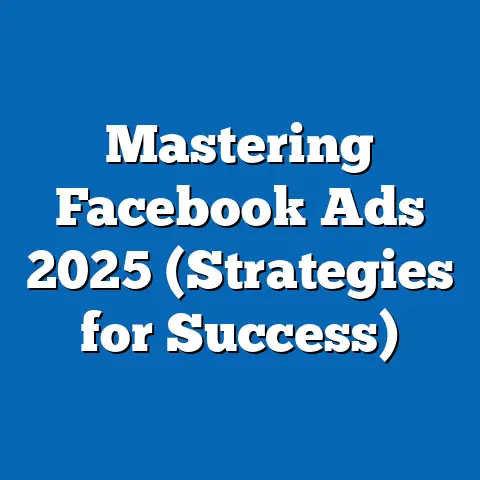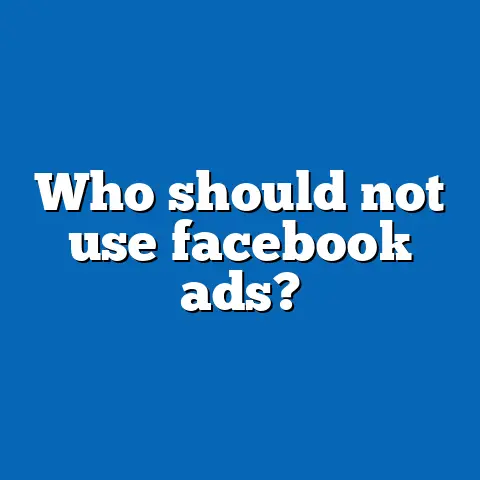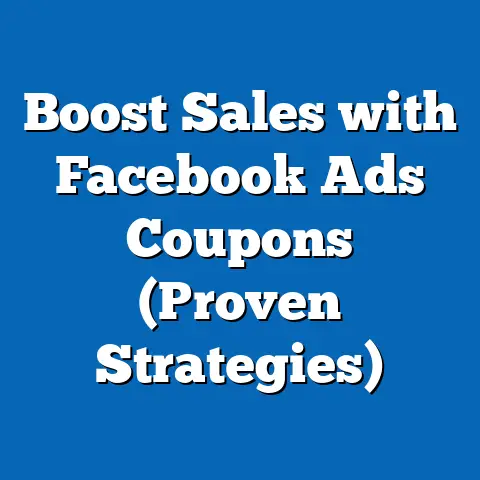Prevent Facebook Ad Account Closure (Essential Strategies)
Imagine waking up one morning, ready to launch a new campaign, only to find your Facebook ad account suspended. Your heart sinks. Your carefully planned strategy, the potential customers you were about to reach, all gone in an instant. What would your business lose if your Facebook ad account were suddenly shut down—your revenue, your audience, your very lifeline? This isn’t just a hypothetical scenario; it’s a reality many businesses face, and the consequences can be devastating.
I’ve seen firsthand the panic and frustration that comes with an unexpected ad account closure. I remember working with a small e-commerce business that relied heavily on Facebook ads for their sales. They had built a strong brand presence and a loyal customer base through targeted campaigns. Then, seemingly out of nowhere, their ad account was disabled. The reason? A minor policy violation they weren’t even aware of. It took weeks to resolve the issue, and during that time, their sales plummeted, and they struggled to recover.
The good news is, preventing this nightmare is possible. By understanding Facebook’s policies, proactively managing your account, and implementing a sustainable advertising strategy, you can significantly reduce the risk of closure. This guide will provide you with essential strategies to keep your Facebook ad account safe and thriving.
1. Understanding Facebook’s Advertising Policies
The first and most crucial step in preventing ad account closure is to become intimately familiar with Facebook’s advertising policies and community standards. Think of these policies as the rulebook for playing the Facebook advertising game. Ignoring them is like driving without knowing the traffic laws – you’re bound to crash sooner or later.
- Why It’s Important: Facebook’s policies are designed to protect users, maintain a positive platform environment, and ensure fair advertising practices. Violating these policies, even unintentionally, can lead to warnings, ad disapprovals, or, in severe cases, permanent account closure.
- Common Reasons for Ad Account Closure:
- Policy Violations: This is the most frequent culprit. Common violations include promoting prohibited products or services (like weapons or illegal substances), making misleading or deceptive claims, using sensational or inflammatory content, or violating copyright laws.
- Misleading Content: Ads that are deceptive, make false promises, or conceal information are a major red flag for Facebook. This includes “clickbait” headlines, fake news, or ads that lead users to unexpected or irrelevant landing pages.
- Inappropriate Targeting: Targeting ads to sensitive categories (like age, race, religion, or health conditions) is strictly prohibited. Facebook wants to prevent discrimination and ensure that ads are relevant and respectful to all users.
- Circumventing Systems: Attempting to bypass Facebook’s ad review process or using cloaking techniques to show different content to Facebook than to users is a serious offense.
- Poor Landing Page Experience: Ads that lead to landing pages with broken links, slow loading times, or irrelevant content can negatively impact your ad quality score and lead to disapproval or account suspension.
- Statistics and Anecdotes: According to a recent study by Social Media Examiner, policy violations are the leading cause of ad account suspensions, affecting nearly 40% of advertisers. I’ve personally seen countless businesses lose their accounts over seemingly minor infractions, highlighting the importance of meticulous compliance.
- Policy Violations: This is the most frequent culprit. Common violations include promoting prohibited products or services (like weapons or illegal substances), making misleading or deceptive claims, using sensational or inflammatory content, or violating copyright laws.
- Misleading Content: Ads that are deceptive, make false promises, or conceal information are a major red flag for Facebook. This includes “clickbait” headlines, fake news, or ads that lead users to unexpected or irrelevant landing pages.
- Inappropriate Targeting: Targeting ads to sensitive categories (like age, race, religion, or health conditions) is strictly prohibited. Facebook wants to prevent discrimination and ensure that ads are relevant and respectful to all users.
- Circumventing Systems: Attempting to bypass Facebook’s ad review process or using cloaking techniques to show different content to Facebook than to users is a serious offense.
- Poor Landing Page Experience: Ads that lead to landing pages with broken links, slow loading times, or irrelevant content can negatively impact your ad quality score and lead to disapproval or account suspension.
Takeaway: Dedicate time to thoroughly review Facebook’s advertising policies and community standards. Keep them handy and refer to them regularly, especially when creating new campaigns or experimenting with new ad formats.
2. Proactive Account Management
Maintaining a “clean” ad account is like keeping your house in order – it prevents problems from piling up and becoming overwhelming. Proactive account management involves regularly monitoring your account, addressing issues promptly, and adhering to best practices.
- Significance of a Clean Ad Account: A well-maintained ad account signals to Facebook that you’re a responsible advertiser who respects their platform and their users. This can lead to better ad performance, lower costs, and a reduced risk of suspension.
- Regular Monitoring and Compliance Checklist:
- Ad Performance: Track key metrics like click-through rate (CTR), conversion rate, and cost per acquisition (CPA). Identify underperforming ads and make necessary adjustments or pause them.
- Ad Approvals: Regularly check your ad account for any disapproved ads. Understand the reasons for disapproval and make the necessary corrections before resubmitting.
- Payment Information: Ensure your payment information is up-to-date and accurate. Expired or invalid payment methods can trigger account suspensions.
- Policy Compliance: Double-check all your ads and targeting options against Facebook’s policies. Look for any potential violations, even if they seem minor.
- User Feedback: Monitor comments and reviews on your ads and Facebook Page. Address any negative feedback promptly and professionally.
- Understanding Facebook’s Algorithms: Facebook’s algorithms play a crucial role in determining ad delivery, relevance, and cost. Understanding how these algorithms work can help you optimize your campaigns and avoid triggering any red flags. For example, using high-quality images, writing engaging copy, and targeting the right audience can improve your ad relevance score and increase your chances of success.
- Ad Performance: Track key metrics like click-through rate (CTR), conversion rate, and cost per acquisition (CPA). Identify underperforming ads and make necessary adjustments or pause them.
- Ad Approvals: Regularly check your ad account for any disapproved ads. Understand the reasons for disapproval and make the necessary corrections before resubmitting.
- Payment Information: Ensure your payment information is up-to-date and accurate. Expired or invalid payment methods can trigger account suspensions.
- Policy Compliance: Double-check all your ads and targeting options against Facebook’s policies. Look for any potential violations, even if they seem minor.
- User Feedback: Monitor comments and reviews on your ads and Facebook Page. Address any negative feedback promptly and professionally.
Takeaway: Implement a regular monitoring schedule for your ad account. Use the checklist above to ensure you’re covering all the essential areas. Stay informed about changes to Facebook’s algorithms and adjust your strategies accordingly.
3. Creating High-Quality, Compliant Ads
The quality of your ads is directly linked to the health of your ad account. Creating high-quality, compliant ads not only improves your performance but also demonstrates to Facebook that you’re a responsible advertiser who prioritizes user experience.
- Guidelines for Compliant Ads:
- Imagery: Use high-resolution images that are relevant to your product or service. Avoid misleading or deceptive imagery.
- Copy: Write clear, concise, and accurate ad copy. Avoid making false claims or exaggerating the benefits of your product or service.
- Calls-to-Action: Use strong, clear calls-to-action that tell users exactly what you want them to do. Avoid using misleading or manipulative calls-to-action.
- Landing Page: Ensure your landing page is relevant to your ad copy and provides a seamless user experience.
- Avoiding Prohibited Content:
- Deceptive Claims: Don’t make claims that are unsubstantiated or misleading.
- Offensive Material: Avoid using language or imagery that is offensive, discriminatory, or hateful.
- Illegal Products or Services: Do not promote products or services that are illegal or regulated.
- Copyright Infringement: Ensure you have the necessary rights to use any images, videos, or music in your ads.
- Examples of Compliant vs. Non-Compliant Ads:
- Compliant: An ad for a fitness app that features a realistic image of someone using the app, clear and concise copy explaining the benefits, and a call-to-action to “Download Now.”
- Non-Compliant: An ad for a weight loss product that features before-and-after photos with unrealistic results, exaggerated claims about weight loss, and a call-to-action to “Buy Now and Lose 20 Pounds in One Week!”
- Imagery: Use high-resolution images that are relevant to your product or service. Avoid misleading or deceptive imagery.
- Copy: Write clear, concise, and accurate ad copy. Avoid making false claims or exaggerating the benefits of your product or service.
- Calls-to-Action: Use strong, clear calls-to-action that tell users exactly what you want them to do. Avoid using misleading or manipulative calls-to-action.
- Landing Page: Ensure your landing page is relevant to your ad copy and provides a seamless user experience.
- Deceptive Claims: Don’t make claims that are unsubstantiated or misleading.
- Offensive Material: Avoid using language or imagery that is offensive, discriminatory, or hateful.
- Illegal Products or Services: Do not promote products or services that are illegal or regulated.
- Copyright Infringement: Ensure you have the necessary rights to use any images, videos, or music in your ads.
- Compliant: An ad for a fitness app that features a realistic image of someone using the app, clear and concise copy explaining the benefits, and a call-to-action to “Download Now.”
- Non-Compliant: An ad for a weight loss product that features before-and-after photos with unrealistic results, exaggerated claims about weight loss, and a call-to-action to “Buy Now and Lose 20 Pounds in One Week!”
Takeaway: Prioritize quality and compliance in every aspect of your ad creation process. Use the guidelines above to ensure your ads are both effective and respectful of Facebook’s policies.
4. Engaging with Customer Feedback
Customer feedback is a goldmine of information that can help you improve your ads, your products, and your overall customer experience. Monitoring and responding to feedback can also help prevent ad account closures by demonstrating to Facebook that you care about your customers and are committed to addressing their concerns.
- Monitoring Customer Feedback:
- Comments on Ads: Regularly check the comments section of your ads for any feedback, questions, or complaints.
- Reviews on Facebook Page: Monitor your Facebook Page for reviews and ratings. Respond to both positive and negative reviews promptly and professionally.
- Direct Messages: Check your Facebook Page inbox for direct messages from customers. Respond to inquiries and address any concerns.
- Role of Engagement Metrics: Engagement metrics like comments, likes, shares, and click-through rate are important indicators of ad quality and relevance. High engagement signals to Facebook that your ads are resonating with your audience, while low engagement can indicate that your ads are not performing well.
- Strategies for Encouraging Positive Interactions:
- Ask for Feedback: Encourage customers to leave reviews or comments on your ads or Facebook Page.
- Respond Promptly: Respond to all feedback, both positive and negative, as quickly as possible.
- Be Professional: Maintain a professional and respectful tone in all your interactions with customers.
- Offer Solutions: If a customer has a complaint, offer a solution to address their concerns.
- Comments on Ads: Regularly check the comments section of your ads for any feedback, questions, or complaints.
- Reviews on Facebook Page: Monitor your Facebook Page for reviews and ratings. Respond to both positive and negative reviews promptly and professionally.
- Direct Messages: Check your Facebook Page inbox for direct messages from customers. Respond to inquiries and address any concerns.
- Ask for Feedback: Encourage customers to leave reviews or comments on your ads or Facebook Page.
- Respond Promptly: Respond to all feedback, both positive and negative, as quickly as possible.
- Be Professional: Maintain a professional and respectful tone in all your interactions with customers.
- Offer Solutions: If a customer has a complaint, offer a solution to address their concerns.
Takeaway: Make customer engagement a priority. Monitor feedback regularly, respond promptly and professionally, and use feedback to improve your ads and your overall customer experience.
5. Utilizing Facebook’s Resources
Facebook provides a wealth of resources to help advertisers succeed, including the Business Help Center, ad approval tools, and support channels. Leveraging these resources can help you stay informed about policies, troubleshoot issues, and optimize your campaigns for better results.
- Facebook’s Business Help Center: The Business Help Center is a comprehensive resource that provides answers to common questions about Facebook advertising. You can find information about policies, ad formats, targeting options, and troubleshooting tips.
- Ad Approval Tools: Facebook’s ad approval tools can help you identify potential policy violations before your ads are published. These tools can also provide guidance on how to correct any issues.
- Support Channels: Facebook offers various support channels, including live chat, email, and phone support. If you encounter any issues or have questions about Facebook advertising, don’t hesitate to reach out for help.
- Benefits of Using Support Channels: I once had an ad account issue related to audience targeting, and I was struggling to understand the policy implications. I reached out to Facebook’s support team via live chat, and they were able to provide me with clear and concise guidance, helping me resolve the issue quickly and avoid any further complications.
Takeaway: Familiarize yourself with Facebook’s resources and don’t hesitate to use them when needed. The Business Help Center, ad approval tools, and support channels can be invaluable tools for navigating the complexities of Facebook advertising.
6. Building a Sustainable Advertising Strategy
Relying solely on Facebook ads for your marketing efforts is like putting all your eggs in one basket. A more sustainable approach involves diversifying your marketing strategy and integrating Facebook advertising with other platforms and channels.
- Importance of Diversification: Diversifying your marketing strategy reduces your reliance on any single platform, mitigating the risk of account closures or algorithm changes.
- Integrating with Other Platforms:
- Email Marketing: Build an email list and use it to nurture leads and promote your products or services.
- Content Marketing: Create valuable content that attracts and engages your target audience.
- Search Engine Optimization (SEO): Optimize your website for search engines to drive organic traffic.
- Social Media Marketing (Other Platforms): Expand your presence to other social media platforms like Instagram, Twitter, and LinkedIn.
- Developing Long-Term Relationships: Focus on building long-term relationships with your audience through organic content, community building, and personalized interactions. This can help you create a loyal customer base that is less dependent on paid advertising.
- Email Marketing: Build an email list and use it to nurture leads and promote your products or services.
- Content Marketing: Create valuable content that attracts and engages your target audience.
- Search Engine Optimization (SEO): Optimize your website for search engines to drive organic traffic.
- Social Media Marketing (Other Platforms): Expand your presence to other social media platforms like Instagram, Twitter, and LinkedIn.
Takeaway: Don’t put all your eggs in one basket. Diversify your marketing strategy and focus on building long-term relationships with your audience.
7. Staying Informed About Policy Changes
Facebook’s advertising policies and community standards are constantly evolving. Staying informed about these changes is crucial for maintaining compliance and avoiding account closures.
- Subscribing to Updates: Subscribe to Facebook’s Business Help Center and other industry news sources to stay informed about policy changes.
- Following Industry News: Follow industry news websites and blogs to stay up-to-date on the latest trends and best practices in Facebook advertising.
- Participating in Online Communities: Join online advertising communities and forums to connect with other advertisers and share information about policy changes.
- Adapting Strategies: Be prepared to adapt your advertising strategies in response to policy shifts. This may involve making changes to your ad copy, targeting options, or landing pages.
- Real-World Example: I remember when Facebook updated its policy on personal attributes, prohibiting advertisers from directly referencing a user’s race, religion, or other sensitive characteristics. Many advertisers were caught off guard by this change and had their ads disapproved. By staying informed about the policy update and adapting their ad copy accordingly, I was able to avoid any disruptions to my campaigns.
Takeaway: Make staying informed about policy changes a priority. Subscribe to updates, follow industry news, and participate in online communities. Be prepared to adapt your strategies in response to policy shifts.
Conclusion
Preventing Facebook ad account closure is an ongoing process that requires proactive management, compliance with policies, and a focus on quality. By understanding Facebook’s advertising policies, maintaining a clean ad account, creating high-quality ads, engaging with customer feedback, utilizing Facebook’s resources, building a sustainable advertising strategy, and staying informed about policy changes, you can significantly reduce the risk of closure and safeguard your advertising efforts.
Don’t wait until it’s too late. Take action today to implement these strategies and protect your Facebook ad account. Your business depends on it.






